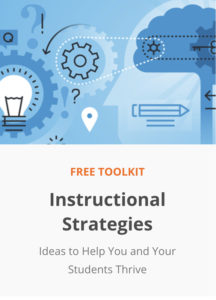Let’s face it: the last year or so has been about the weirdest time any of us can remember. The pandemic has completely changed the way we think about so many things, but undoubtedly one of the biggest shifts has been from a 9–5 working day to a work-from-anywhere (and at any time) mentality.
It may be we were heading in this direction regardless, but the pandemic has pushed us over the edge, turning us into a globally connected society that learns, operates, and progresses in a completely online space.
One of the most impactful effects is that students of all ages have been forced to learn from home. Kids from kindergarten to college age have had to stay home for lessons, complete homework, and even take exams online. It’s been the same for mature students and those receiving workplace-based training.
This has certainly been stressful, but focusing on the drawbacks is pointless and, frankly, a bit depressing. It looks like we’re all going to be learning and teaching from home for a while to come, so to remain optimistic, we’re going to take you through eight key advantages of online learning. After all, it’s not all bad!
Read on to see how online learning, or a blended approach, can actually be highly beneficial.
1. Flexibility
The fact that online learning is, in most cases, more flexible than in-person learning can’t be glossed over. Be honest: how many times have you rolled out of bed and straight into your office, pajamas and all? How many times have you seen your kids do the same?

Learning from home is, in many ways, more convenient. Long commutes, traffic jams…these are things of the past. Because people aren’t having to travel to and from work or school, the hours people are available online are more flexible.
Instead of a standard 9–3 day at school, for example, students can have morning classes or afternoon classes. Some students can even learn from home just a couple of days a week. This is especially useful for those who are studying while holding down a full or part-time job.
2. Accessibility
Distance learning is more physically accessible than in-person schooling, too. Students with physical or learning differences have many more resources available to them than they would in a regular classroom environment.
Take this as an example. Students who are blind or visually impaired can use voice recognition software to assist them with their learning, something they might be unable to do at school or college.
Resources and funding for students with greater access needs are often limited in a standard school environment, so online learning with tools such as IVR and speech-to-text software provides a much-needed alternative.
3. Technical Skills
 We can all agree that technology has revolutionized communication as we know it. This pandemic is simply another stepping stone on the way to a globally online society. It perhaps goes without saying, but online learning facilitates the acquisition of technical skills much better than its in-person counterpart.
We can all agree that technology has revolutionized communication as we know it. This pandemic is simply another stepping stone on the way to a globally online society. It perhaps goes without saying, but online learning facilitates the acquisition of technical skills much better than its in-person counterpart.
Think about it. You have to be confident with online communication software, virtual learning environment programs, and all the other technologies that drive productivity to complete your education online.
Learning a new set of technical skills also goes hand-in-hand with social prowess. It’s much more difficult to work in a team with other students or to communicate effectively with a teacher if one’s technical skills are not up to par.
Thankfully, students seem to be adapting very well to the change, making this issue a long-term strength rather than a short-term handicap.
4. Motivation
 One underrepresented benefit of online learning is it teaches students to motivate themselves and practice self-discipline. This is a great skill to put on your CV and one you can bring up in job interviews as well.
One underrepresented benefit of online learning is it teaches students to motivate themselves and practice self-discipline. This is a great skill to put on your CV and one you can bring up in job interviews as well.
Online learning requires a lot of strength of mind to keep up with it. Students who enjoy distance learning are often more motivated, and the fact it takes place in a home environment contributes massively.
A home environment can reduce anxiety and depression rates in students, as learning is taking place in a more comfortable and familiar space.
This is especially important for younger students. Children aged seven and below benefit more from home learning than older students, due to the reduction in separation anxiety and the resultant increase in engagement and motivation to learn.
5. Cost-Effective
A huge advantage of online learning is the reduction of costs. Aside from the obvious implications of not spending money on commuting, FaaS learning platforms mean resources are only purchased when necessary, which contributes to the overall money-saving attributes of learning from home.
There are a whole host of expenditures that are negated by distance learning:
- Cost of food
- Travel costs
- Government funding
- Funding for SEN students
- Private school fees
- Cost of equipment (books, pens, calculators, etc.)
What this means, in a nutshell, is that online learning is a lot cheaper and therefore more accessible.
Students from lower-income backgrounds benefit most from this phenomenon: money is saved by an absence of travel and reliance on online resources rather than physical books and equipment.
6. Customized Learning Environments
 Online learning means it’s easier for teachers to tailor classes to individuals. This makes it easier to teach those with lower academic achievement records as more time can be allocated to each student without eating up resources.
Online learning means it’s easier for teachers to tailor classes to individuals. This makes it easier to teach those with lower academic achievement records as more time can be allocated to each student without eating up resources.
With the money saved on not having to buy books or equipment, more staff can be taken on to ensure every student gets the support they need to achieve their full potential.
Not only this, but students can customize their learning environment to suit their needs. Even little things like changing the color, font, and layout of learning platforms can make a huge difference to organization and motivation.
A customizable environment might not sound important, but it can make a huge difference to a student’s learning.
7. Critical-Thinking Skills
An online presence means an online mentality. Companies and press outlets around the world all have an agenda, whether progressive or not. Being predominantly online teaches kids not to trust everything they read and gives them the tools to do their research before deciding what they think.
Consider this. When you can Google the answer to every test, learning as a concept completely changes. Why should you believe outdated information when you have an entire world’s worth of knowledge at your fingertips?
Sifting through this is a skill in and of itself. Learning to think critically is a major asset, not only in school but in the workplace as well.
8. Security
Remember that online mentality we talked about? This is how to use it to keep yourself and people you know safe online.
Digital asset security and online safety are two of the biggest problems to consider when approaching a distance learning environment, but with so many options out there, it’s easy to keep students safe.
When deciding on security software, especially if you run a school or a business, making a process map of the measures your platform can’t run without is important. What’s the bare minimum for security? What steps are non-negotiable when it comes to the safety of your users?
Many security programs also run continuous testing. What is continuous testing? Well, to summarize, it’s the practice of testing at every possible stage of development or progress. This means you can rest easy in the knowledge your platform is as protected as possible and can get on with the real business of teaching and learning.
Isn’t it time you considered the advantages of distance learning for yourself, your workers, and/or your students to see whether it could be the perfect next step you’ve been looking for?
Check out Infobase’s Instructional Strategies Toolkit for more ideas that will help you and your students thrive.
See also:
- Source Reference and Learn360 have both won Tech & Learning Awards of Excellence for remote and blended learning. Learn more about Source Reference and Learn360.
- A Guide to Instructional Design in eLearning
- 5 Practical Uses of AR and VR in Distance Learning
- Time to Explore Virtual Engagement Tools
- 9 Distance Learning Ideas to Help Students with Restricted Internet Access


